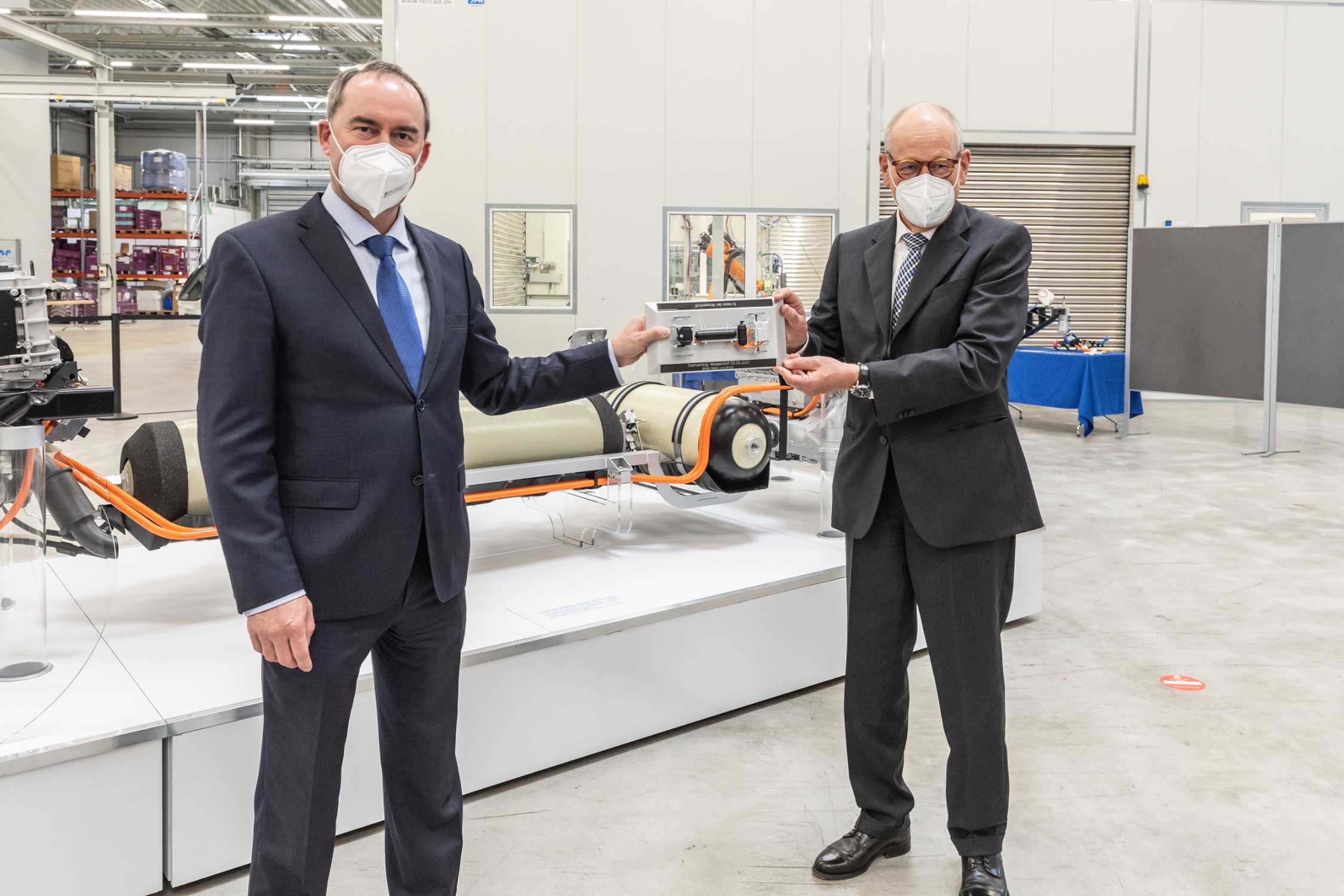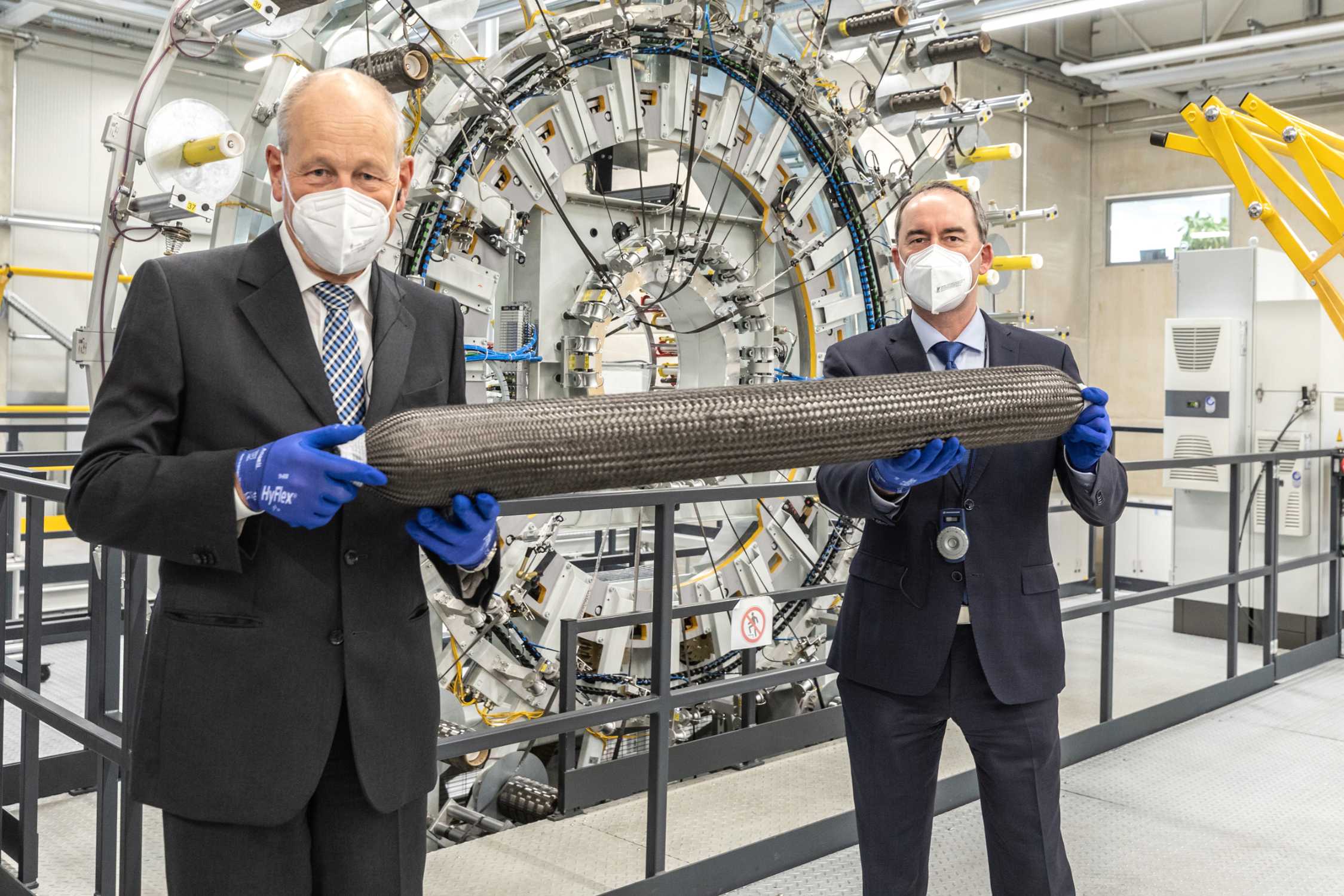PressClub Middle East · Article.
Innovation driver for hydrogen technology and tomorrow’s sustainable CO2-free mobility
Mon May 03 12:00:00 CEST 2021 Press Release
+++ Bavarian Economic Affairs Minister Hubert Aiwanger and BMW Group Board of Management Member Dr Andreas Wendt impressed by Landshut Lightweight Construction and Technology Centre’s expertise in manufacturing components for hydrogen propulsion +++ Innovative capabilities and industrialisation expertise showcased in small series of BMW i Hydrogen NEXT from 2022
Press Contact.
Osama El-Sherif
BMW Group
Tel: +971-4-3129-964
send an e-mail
Author.
Osama El-Sherif
BMW Group
+++ Bavarian Economic Affairs Minister Hubert Aiwanger and BMW Group Board of Management Member Dr Andreas Wendt impressed by Landshut Lightweight Construction and Technology Centre’s expertise in manufacturing components for hydrogen propulsion
+++ Innovative capabilities and industrialisation expertise showcased in small series of BMW i Hydrogen NEXT from 2022
Landshut. Development of CO2-free drive technologies is a top priority for the BMW Group. Hydrogen vehicles can also play an important role in the growth of e-mobility and will become an additional option in the long term. Just like electric vehicles, hydrogen vehicles come with an electric drive train. However, they do not obtain the energy they need from high-voltage batteries, but produce it directly on board the vehicle from hydrogen. In this way, the use of innovative hydrogen technology can help further decarbonisation.
The Lightweight Construction and Technology Centre (LuTZ) in Landshut plays a key part in this by producing essential components for the hydrogen-electric drive train that will be installed in the BMW i Hydrogen NEXT from 2022 and supplying them for installation of the fuel cell system in Munich. Bavarian Minister of Economic Affairs Hubert Aiwanger and BMW Group Board of Management Member Dr Andreas Wendt were able to see the company’s strong innovation capabilities and industrialisation expertise in the field of hydrogen for themselves at today’s “Hydrogen Technology Day”.
“I am convinced hydrogen technology will gain traction – and I am committed to making Bavaria a high-tech location for hydrogen technology. This is a constructive way of responding to the climate debate,” stated Hubert Aiwanger, Deputy Minister-President of Bavaria and the state’s Minister for Economic Affairs, Regional Development and Energy, on a visit to the component plant in Landshut in Lower Bavaria. “The focus now is on building a hydrogen infrastructure at national and international level, from production to application.”
“Here at our Lightweight Construction and Technology Centre, we are creating important innovations for the mobility of the future,” said Dr Andreas Wendt, member of the Board of Management of BMW AG responsible for Purchasing and Supplier Network. “We are developing highly complex components tailored to the demands of our cars. In this way, the location is making a vital contribution to the company’s transformation towards e-mobility. More than ever, our in-house component production in Landshut serves as an innovation driver.”

Small series of second-generation BMW i Hydrogen NEXT from late 2022
Hydrogen vehicles generate the electrical energy needed from hydrogen directly in the vehicle and offer a number of advantages. They are best suited for customers who frequently drive long distances, require a great deal of flexibility or do not have regular access to electric charging infrastructure. Refuelling takes just a few minutes, as it does with conventional fuels. Vehicles that run on hydrogen produced using renewable energy can make an important contribution to meeting climate goals.
The BMW Group will pilot a small series of the BMW i Hydrogen NEXT from 2022, based on the current BMW X5 and equipped with a hydrogen fuel cell e-drive that only emits water vapour. The BMW Group is building on its experience with fifth-generation e-drives to develop this vehicle.
However, the conditions needed to be able to offer BMW Group customers a hydrogen vehicle are not yet in place. Further commitment is necessary – particularly with regard to the hydrogen filling infrastructure and requirements throughout the entire energy system, where green hydrogen must be available in sufficient quantities and produced at competitive prices for individual mobility.
In Germany, the European Union and other major regions of the world, lawmakers have recognised the significance of green hydrogen for the energy system of the future. The European Union has mad hydrogen technology a focal point with the “Green Deal”. The BMW Group welcomes these activities. Major Asian markets, such as Japan, Korea and China, have expressed a strong interest in establishing infrastructure for hydrogen vehicles. The conditions for hydrogen fuel cell vehicles will develop differently around the world.

Highly innovative components from Landshut for fuel cell system
Preparations are already underway in Landshut for the fuel cell system that will be used in the BMW i Hydrogen NEXT from 2022. The production location in Lower Bavaria will manufacture highly innovative components for the small series: the so-called stack housing made of light metal, which holds the fuel cells, and the media end plate made of plastic and light metal castings, which creates an air and watertight seal around the stack housing. “Media” refers here to the hydrogen, oxygen and coolant that are channelled into the housing through the media end plate to initiate the chemical reaction in the fuel cells. These complex components are specifically designed to withstand prolonged contact with hydrogen.
"Having the Lightweight Construction and Technology Centre here at the site gives us a real advantage over our competitors. We have innovative capabilities and industrialisation expertise; we are able to develop strategically crucial innovations ourselves and, at the same time, we can reliably assess external partners and suppliers,” said Dr Wolfgang Blümlhuber, head of Technology Driving Dynamics, Light Metal Casting in the Purchasing and Supplier Network. “In a technological transformation, success doesn’t happen by itself. Courage, pioneering spirit and a long-term shift in competence have been part of the secret of our success in the past – and our highly qualified employees and their willingness to change play a key role,” according to Willibald Löw, Chairman of the Works Council of BMW Group Plant Landshut.
Fuel cell system in the BMW i Hydrogen NEXT
Within the drive train, the fuel cell system of the BMW i Hydrogen NEXT is continuously fed with hydrogen from CFRP tanks and generates up to 125 kW of electrical power for the electric motor mounted on the rear axle. The underlying mechanism for this is a chemical reaction between hydrogen and oxygen, with water the only reaction product. Two 700-bar tanks, which together hold six kilograms of hydrogen, guarantee extensive range in all weather conditions and can be refilled in just three to four minutes.
The electric motor in the BMW i Hydrogen NEXT is the same highly-integrated fifth-generation e-drive used for the first time in the BMW iX3. The high-voltage battery that sits above the e-drive serves as a performance buffer and provides additional dynamics for acceleration. The drive train system delivers a total output of 275 kW (374 hp).
Over 40 years of experience with hydrogen technology
The BMW Group has over 40 years of experience with hydrogen technology and more than 20 years in the field of hydrogen fuel cell technology. Both the technology and the BMW i Hydrogen NEXT are being developed in Munich. Hydrogen is also not new to the Landshut location: Back in 2000, Plant Landshut fitted the technology flagship of the day, the BMW Hydrogen 7, with a hydrogen combustion engine and cast components shaped using sand cores. “Plant Landshut represents the power of innovation from Lower Bavaria,” underlined Dr Stefan Kasperowski, head of BMW Group Plant Landshut. “With the current innovations for alternative CO2-free drive technologies, the BMW Group is once again making a clear commitment to the location.” As the BMW Group’s largest component plant worldwide, the Landshut location has six different technologies at its command and concentrates cross-technology pre-development expertise at the Lightweight Construction and Technology Centre.
In addition, the BMW Group is already using hydrogen fuel cell technology wherever it makes sense to do so: The fleet of several hundred fork-lift trucks with fuel cell drive trains currently deployed in logistics at the car plants in Spartanburg and Leipzig will be further expanded in stages.